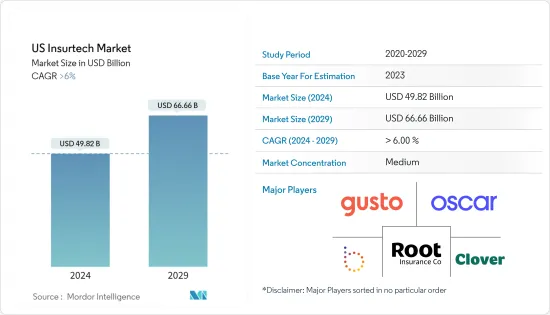PUBLISHER: Mordor Intelligence | PRODUCT CODE: 1537695

PUBLISHER: Mordor Intelligence | PRODUCT CODE: 1537695
US Insurtech - Market Share Analysis, Industry Trends & Statistics, Growth Forecasts (2024 - 2029)
The US Insurtech Market size is estimated at USD 49.82 billion in 2024, and is expected to reach USD 66.66 billion by 2029, growing at a CAGR of greater than 6% during the forecast period (2024-2029).

The United States is the largest insurance market globally, and it has been a hotbed for insurtech companies. The market has experienced substantial growth in recent years, with investments pouring into insurtech startups. Insurtech has attracted significant venture capital investment. Insurtech companies leverage various technologies such as artificial intelligence (AI), machine learning (ML), big data analytics, the Internet of Things (IoT), and blockchain to streamline processes, enhance underwriting accuracy, automate claims handling, and personalize insurance products. Insurtech has facilitated the emergence of new insurance models, such as peer-to-peer (P2P) insurance, on-demand insurance, and usage-based insurance (UBI). These models offer more tailored coverage options and flexible pricing based on individual risk profiles. Insurtech companies in the United States focus on improving customer experience by offering user-friendly digital platforms, simplified policy purchasing processes, and faster claims settlement.
The post-COVID-19 scenario of the United States insurtech market is experiencing significant growth. Insurtech companies are leveraging technology to provide innovative solutions and streamline insurance processes. Factors like increased digitization, rising customer expectations, and the need for personalized insurance offerings are driving the market.
US Insurtech Market Trends
Surged Funding towards Insurtech Companies
The Insurtech companies are flourishing. The companies in the insurtech sector raised over USD 27 billion in private funding in just over 350 deals in the previous year. The pandemic has accelerated the industry's digital transformation by at least five years forcing incumbents to open or enhance digital distribution channels and to make corresponding upgrades to back-office capabilities. The demand for digital solutions is increasing across the insurance value chain, from quote issuance to claim settlement, as our interviews with insurtech C-suite executives showed.
Non Life Insurance is Increasing with Higher Rate
The increase in non-life insurance, also known as property and casualty insurance, is indeed contributing to the growth of the Insurtech market in the United States. The surge in non-life insurance is prompting insurers to adopt insurtech solutions for various reasons. Advanced data analytics and artificial intelligence enable more accurate risk assessment, helping insurers better understand and price policies for non-life coverages like property and casualty. This enhances underwriting precision and reduces the likelihood of losses. Insurtech facilitates improved customer experiences. Digital platforms and mobile apps enable policyholders to purchase, manage, and claim insurance seamlessly, enhancing customer satisfaction and loyalty. Furthermore, insurtech supports automation in claims processing. This expedites the settlement process for non-life insurance claims, reducing administrative costs and increasing overall operational efficiency.
US Insurtech Industry Overview
The United States insurtech industry is fragmented, with many players in the market. The United States insurtech industry is highly competitive, with the presence of both international and domestic players. Some players currently dominate the market, which includes Gusto, Oscar, Bright Health, Clover Health, and Root Insurance. The market studied presents opportunities for growth during the period, which is expected to further drive the market competition. With multiple players holding significant shares, the market studied is competitive.
Additional Benefits:
- The market estimate (ME) sheet in Excel format
- 3 months of analyst support
TABLE OF CONTENTS
1 INTRODUCTION
- 1.1 Study Assumptions and market definition
- 1.2 Scope of the Study
2 RESEARCH METHODOLOGY
3 EXECUTIVE SUMMARY
4 MARKET DYNAMICS
- 4.1 Market Overview
- 4.2 Market Drivers
- 4.2.1 Growing Demand for Data Analytics and Artificial Intelligence
- 4.2.2 Increasing Adoption of Digital Technologies
- 4.3 Market Restraints
- 4.3.1 Concerns about Data Privacy and Cybersecurity Impact Digital Insurance Platforms
- 4.4 Market Opportunities
- 4.4.1 Rising Demand for Innovative Solutions in Areas like Cybersecurity, Digital Health, and Telematic Presents
- 4.5 Porter's Five Forces Analysis
- 4.5.1 Bargaining Power of Suppliers
- 4.5.2 Bargaining Power of Buyers/Consumers
- 4.5.3 Threat of New Entrants
- 4.5.4 Threat of Substitute Products
- 4.5.5 Intensity of Competitive Rivalry
- 4.6 Insights on Various Technologies Driving the Insurtech Space Growth in United States
- 4.7 Insights on Regulatory Framework And Roadblocks for acquiring Fintech Licensing in United States
- 4.8 Funding And Investment Activity in Insurtech Space in United States
- 4.9 Impact of Insurtech in United States Insurance Industry
- 4.10 Impact of COVID-19 on the Market
5 MARKET SEGMENTATION
- 5.1 By Business Model
- 5.1.1 Carrier
- 5.1.2 Enabler
- 5.1.3 Distributor
- 5.2 By Insurance Type
- 5.2.1 Life Insurance
- 5.2.2 Non-Life Insurance
6 COMPETITIVE LANDSCAPE
- 6.1 Market Concentration Overview
- 6.2 Company Profiles
- 6.2.1 Gusto
- 6.2.2 Oscar
- 6.2.3 Bright Health
- 6.2.4 Clover Health
- 6.2.5 Root Insurance
- 6.2.6 American Well
- 6.2.7 Lemonade
- 6.2.8 Outsystems
- 6.2.9 Next Insurance
- 6.2.10 Metromile
- 6.2.11 Hippo*
7 FUTURE OF THE MARKET
8 DISCLAIMER




